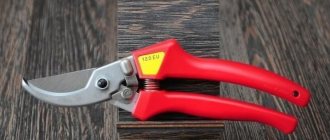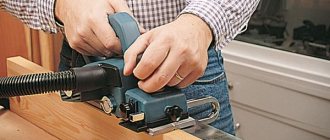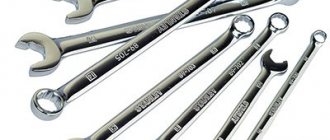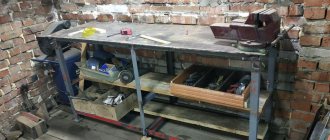Ax rating
Manufacturers produce forged and stamped products, tools for chopping wood and carpentry. To compile the review, the VyborExperta.ru team selected products from popular brands, famous factories and new brands on the market. Testing was carried out, the performance characteristics and properties of the materials used in manufacturing were studied. Reviews from users, professional carpenters, tourists and hunters were taken into account.
When compiling the rating, special attention was paid to the following operating parameters:
- The shape of the blade changes depending on its purpose;
- Blade material – carbon, alloy, tool steel is used, differing in its characteristics;
- Handle - made of different materials, which affects the price, ease of use and service life;
- Weight – affects the level of effort that will have to be expended during work;
- Size – a large hatchet is a hindrance on a camping trip; small ones find it difficult to chop wood;
- Safety – a sharpened blade can cause injury; the presence of a cover and its quality are an important selection parameter.
Not all the tools met the requirements of our experts. Blades made of raw metal, a dried handle, chips and cracks in the handle - such axes were excluded from our rating.
The best wood splitters
Selection of head material
When buying an ax, carefully inspect its head, because during operation this part will experience the greatest loads, it should be free of cracks and chips, check the geometry of the product, it may be damaged during manufacturing, which
will significantly complicate operation and reduce the accuracy of strikes. A good product is made from tool carbon or alloy steel. For domestic manufacturers, Soviet metal markings are still relevant: U7A, U8, U8A, U8GA, 65G are the most suitable. If for some reason it is not possible to find out the brand from the seller or there is no description, you can check the quality of steel using the “old-fashioned method”, to do this you need to hit the head of the axe, preferably with some small metal object and listen carefully to the resulting sound, it should be clear, and a dull sound is a sign of poor quality.
The best splitting axes
It is better to chop wood with a tool with a narrow but thick blade. When you hit a log with such an ax, the tree cracks along the fibers. This reduces the amount of physical effort that has to be spent on hard housework. With a good swing, you can split a log with the first blow. A long handle is better for this. Manufacturers took into account the specifics of the work and developed an ax for chopping wood, which in common parlance was called a “cleaver.”
Fiskars X17
The oldest manufacturing company in Finland has developed a cleaver that meets the most stringent requirements. The convex shape of the wedge helps to effectively split logs and quickly pull the blade out of the log. The production uses high-quality carbon steel, which is characterized by high strength and corrosion resistance. Double hardening helps to withstand maximum loads. An anti-friction coating provides additional protection against corrosion.
The handle is made of patented FiberComp material, which is lightweight, durable and wear-resistant. The hook-shaped handle profile provides a comfortable grip and reduces physical strain during prolonged work. The blade is firmly fixed to the handle and will not fall off when swinging. Users note high efficiency when working with raw firewood.
Advantages:
- Excellent balance between blade and axe;
- Plastic case for storage and carrying;
- Comfortable handle length;
- Copes well with 20-25 cm logs;
- High quality sharpening.
Flaws:
- Overcharge.
The Finnish Fiskars splitting ax is easy to use due to the SoftGrip structure of the handle. The palm is non-slip, and good shock absorption properties reduce shock loading, providing comfort and high performance.
Patriot PA 711
For a cleaver designed for intensive work, a blade made of forged steel with double hardening was chosen. High-precision grinding and a sharpening angle of 35 degrees ensure high labor productivity when using the tool. The expanding shape of the wedge ensures that the user can easily remove the ax from a damp log. A patented Teflon-based coating will also help with this.
The American firewood splitting ax attracts professionals with its X-Rigid fastening system, which guarantees reliable fixation of the blade to the handles. Anti-stall protection has a positive impact on safety and eliminates the need for maintenance. The handle is made of impact-resistant fiberglass reinforced plastic. The curved profile is convenient for a confident grip and provides a high speed of smell.
Advantages:
- Plastic case;
- Rubberized handle;
- Well balanced;
- Light weight;
- Easily handles logs up to 30 cm in diameter.
Flaws:
- The decorative paintwork will peel off quickly.
DDE Dynamic AX9 (649-370)
The compact cleaver weighs only 0.68 kg, which makes it a good choice not only for working in the country or in the garden, but also for hiking. The steel blade is coated with an anti-friction coating, guaranteeing high corrosion resistance. The butt is well pressed, this ensures the required safety and no loss of time on regular maintenance.
The short handle is made of durable polyamide reinforced with fiberglass. The rubberized coating helps to confidently fix the ax in your hands during a strong swing. Despite its small size, the manufacturer managed to give the handle an ergonomic shape that prevents the palm from slipping during intensive work.
Advantages:
- Good weight distribution;
- Low price;
- High-quality sharpening;
- Protective carrying case;
- Versatility.
Flaws:
- It is inconvenient to chop large logs.
Structural elements
An ax consists of a head and a handle called an ax handle. Depending on the purpose, the shape may change slightly to adapt to specific jobs, but the configuration as a whole is unchanged.
Upon closer examination we can distinguish:
- eye - this is a hole used to fix the ax;
- beard - serves for more reliable mating of parts by increasing the support area; upon impact, it distributes the load transmitted to the handle;
- toe and heel - the upper and lower angles of the blade, a smaller degree will help to perform delicate work;
- blade - the sharpened part, usually 5-10 mm, the angle varies from 25 to 50 degrees, depends on the functionality of the product, the metal in this area is subjected to hardening;
- cheeks - side parts. The longer they are, the deeper the tool can penetrate into the processed raw material with a single blow;
- Tail - necessary to prevent the tool from slipping during operation, serves as a kind of stop;
- Butt - used for impact, can be used instead of a hammer for imprecise and few jobs.
The best carpenter's axes
Carpenters use axes to remove bark, trim, remove defects, and make grooves. A special feature of the tool is its small size and semicircular cutting edge. Most manufacturers offer models with forged steel blades. Durable metal is easy to sharpen well and copes well with hardwood. The VyborExpert.ru team tested 7 tools and chose carpenter axes that truly meet the requirements of professionals and are designed for intensive daily work.
Husqvarna 5769264-01
A lightweight ax designed for carpentry and chopping wood. Its small size and thick leather cover make it easy to carry in a backpack. User reviews of the universal ax note the high quality of the Swedish steel from which the blade is made. Factory sharpening does not require modification; the tool can easily cope with hardwood.
The butt is securely connected to the ax handle using two wedges made of wood and steel. The handle is made of American walnut, which is highly durable and resistant to vibration loads. The tool fits comfortably in the hand thanks to the classic handle shape, which allows you to work at any angle. The handle does not slip and provides a confident grip.
Advantages:
- Durable blade;
- A light weight;
- Reliable grip when working with gardening gloves;
- Well balanced;
- There are no geometric defects along the axis.
Flaws:
- Overcharge.
Gardena 1400A (8716-48)
The special treatment of the blade makes it easy to work with wood: the applied coating reduces friction. The considerable weight of the butt of 1 kg makes the hard work of processing hard wood simple. The shape of the blade helps concentrate the impact force at the splitting point. The model can be used in the workshop and for felling small trees. The sledgehammer ax is used to hammer in felling wedges.
The handle is made of durable fiberglass reinforced plastic. A special stainless steel cover protects the handle from damage if the user misses the log while chopping. Rubberized pads provide a secure grip.
Advantages:
- Original design;
- Availability of a carrying and safety case with a comfortable handle;
- Manufacturer's warranty 25 years;
- High-quality sharpening;
- Versatility.
Flaws:
- Overcharge;
- Straight handle profile.
Fireman's hatchet
One of the most important types of tools used by firefighters. Usually worn on a belt together and helps the firefighter move along inclined and sliding planes. Typically, a fireman's hatchet is made from high quality forged steel. It has a wedge-shaped blade. The blade is divided into a blade and a pick. The sharp part of the blade is used to cut wooden beams and floors of houses. It is they that collapse during fires and impede forward movement. The blade is used to cut down parts of roofs and attics, windows and doors of a burning building. And with the help of a pick, the firefighter clings to the roof and can subsequently be held on it or on other unstable planes. Thanks to the pick, it becomes possible to catch the tip on the hatch and open the tank with water or steam generator. And if the ax is isolated from electricity, then it can cut electrical conductors.
For convenient carrying of the fireman's ax, it is equipped with a holster attached to the belt. The ax handle is covered with rubber to prevent the tool from slipping in your hands. It also softens shock vibrations and has an insulating effect when cutting live wires.
Fireman's axes are made especially reliably: the blade is pressed onto a metal handle and secured with a steel wedge. Of course, this gives the instrument greater resistance to destruction. The handle of the tool has grips with locks, specifically for easy holding of the ax. This significantly reduces the fatigue of firefighters because they have to make a lot of chopping movements.
- Weighs no more than 1.2 kg.
- The length is 365 mm.
Such an ax, thanks to its reinforced structure and excellent quality blade, lasts for about 8 years. At the same time, this instrument is the only one that is tested once a year during its service life. The handle and blade of the tool are struck with a massive hammer without hardening. If the ax has held up and the metal on the surface has not become wrinkled or split, then the tool is in perfect order and can be used further.
A fireman's ax must have:
- wear resistance, durability
- resistance to melting and sudden temperature changes in general
- rust resistant
- frost resistance
- resistance to physical damage
Which ax is better from the list we have listed? It's up to you to decide and choose.
The best all-purpose axes
Light weight, shortened handle - a tool with these characteristics can be taken on a hike or put in the trunk of a car. The flared shape of the blade makes the tool convenient for processing large diameter logs. It can be used to drive felling wedges and nails. In skillful hands, this is a reliable carpenter's tool.
Bison 20643-06
Made from hardened tool steel and has a one-piece forged design. This allows you to forget about the butt flying off the axe. High quality metal guarantees a long service life. The one-piece design will not allow the handle to break during intensive work. The handle is rubberized, non-slip, and provides a strong grip. The comfortable profile fits any palm size.
The handle length is 40 cm - the tool easily fits in a travel backpack. A leather cover is provided to protect against accidental cuts. The blade has a universal sharpening, the ax can be used for chopping firewood and trimming a trunk. The model easily copes with thick branches.
Advantages:
- Modern design;
- Low price;
- Good balance;
- Long service life.
Flaws:
- Not suitable for hard wood.
Verto 05G201
The model attracted attention with its rigid landing of the butt, which did not fly off the ax during the most intense work. User reviews indicate that the blade remains stably in place even after several years of use. The cutting tool is made of carbon steel. A special coating additionally protects against corrosion.
The handle is made of lightweight and durable fiberglass. The ergonomic shape of the handle reduces physical fatigue during prolonged work. The rubberized and textured surface makes for a secure grip even in wet weather. The handle has a hole for a wrist loop.
Advantages:
- Copes well with branches and tree growth;
- Light weight;
- Proper weight distribution;
- Long service life;
- Attractive price.
Flaws:
- To cut logs, you will need to fine-tune the sharpening.
The best tourist axes
On a hiking trip, every gram of cargo plays a role; car tourists are well aware of the problem of a lack of usable space in the trunk. For these reasons, the classic camping ax is light in weight and small in size. The compact blade copes well with cutting branches and young trees. With this tool you can prepare firewood for a fire, pitch a tent or build a canopy.
Stayer 2064-06
The ax is made of tool steel, resistant to corrosion and characterized by high strength characteristics. The blade has additional hardening and does not dull. The handle is made of reinforced fiberglass, which helps reduce the weight of the tool. The total length is only 250 mm, the tool can be carried in a backpack, on a belt, it does not take up much space in the trunk.
The comfortable shape of the handle is designed for users with any palm width. The rubberized handle makes the grip secure even when used in the rain. The hole in the handle can be used to install a loop that is worn around the wrist.
Advantages:
- Thoughtful ergonomics;
- Good sharpening for cutting branches;
- Protective cover on the blade;
- Low price;
- Can be used as a hammer.
Flaws:
- To cut logs, you need to improve sharpening.
Kraftool 20645-06
The solid forged ax is made of tool steel, resistant to corrosion. With a length of 36 cm, it weighs less than a kilogram. It copes well with thick branches thanks to its sharp sharpening. The design forgets to forget about the need for periodic repair of the butt. There is no need to insert wedges into a dry handle.
The handle is rubberized and does not slip when used in the rain. The three-component handle with thoughtful ergonomics reduces fatigue during prolonged work. The flat head turns the lightweight ax into a reliable hammer that can be used to hammer into tent wedges.
Advantages:
- Good balance;
- Additional hardening of the blade;
- Protective case;
- Long service life.
Flaws:
- Overcharge;
- No lanyard hole.
History of the instrument
If we do not consider the ax in its classical sense, then primitive people began to use such a tool. In their case, it was a simple pointed stone. Despite its different appearance, the object actually performed the functions of a modern axe. It was used as a hammer, scraper, and weapon. In addition, the stone served to perform many other actions.
If we talk about the ax as we imagine it now, then it appeared thirty thousand years ago. At that time, people did not yet know how to insert one part of the instrument into another, so using the device was a problematic task for them. The blade and the ax handle were connected to each other using animal veins, but this method was very unreliable; the tool did not last long.
Over time, people learned to smelt copper. Since then, axes began to be made of metal. In those days, these instruments were a sign of power and might. That is why in the tribes their storage was entrusted only to the elders. The instrument was issued to ordinary people only for a while. Christian missionaries broke this tradition; axes began to be issued to everyone who wanted to receive them.
In the eighth century AD, Europe faced a problem - most of the areas were occupied by forests. During this period, axes began to become popular, as they were used to cut down trees.
Later, at the beginning of the nineteenth century, the United States began producing axes in large quantities. This was due to the same problem as in Europe. Now you can see many different types of this device, which you can learn about below.
The best ax 3 in 1
Engineering does not stand still; for this reason, a modern tool does not look like a stone ax. One of the main requirements of our time is versatility. This became the reason for the appearance of axes with additional functionality. Minor changes to the main structural elements turn the faithful assistant of a lumberjack or carpenter into a hammer, sledgehammer, or nail puller.
Tesla 3 in 1, 600716
The size and weight of the tool makes it a good choice for backpacking. With a length of 355 mm, the total weight is only 860 g. The reason is the handle made of reinforced fiberglass, which is highly durable. The tool steel blade has a universal shape, which is convenient not only for chopping branches, but also for splitting small logs and hewing boards.
The handle has a traditional straight shape and an anti-slip coating. The manufacturer abandoned the complex profile for one reason: the cavity of the handle is used to store auxiliary tools. The case contains a hand saw with double-sided sharpening and a flint intended for starting a fire. To this feature it is worth adding the ability to use the back side of the butt as a hammer and hammer in staples, tent stakes, and nails.
Advantages:
- The handle softens recoil upon impact;
- Carrying case included;
- Low price;
- Good quality steel;
- An easy-to-use hacksaw.
Flaws:
- The hacksaw is tightly fixed in the magazine - difficult to get out.
How to choose an ax
Working with hand tools requires physical effort. A correctly chosen ax will ensure optimal labor productivity and will not cause premature fatigue. Manufacturers offer different types of products that differ in their purpose. Good reviews for universal axes; this tool will take its rightful place in a summer resident’s arsenal. To solve important tasks, you need to choose a tool based on the shape of the blade, ergonomics of the handle, weight and safety during operation.
View
Developers take into account the scope of application and offer products aimed at performing specific functions. It’s easy to chop wood with a cleaver, but the long handle will get in the way when hewing boards and forming locks in a log. Carpenters can use their own tools to split the logs, but with a log 30 cm in diameter it is better to use a specialized tool.
You can take a carpenter's ax on a hike, but it is better to choose a special model for tourists. With similar dimensions, it will weigh less, and the sharpening is more suitable for chopping wood. For those who have a summer house, who like to go hiking and work in a home workshop, universal models are more suitable. Engineers have found a reasonable compromise, and manufacturers are producing axes that can easily cope with various tasks.
Blade
Blades made of tool or high-carbon steel are preferred. This metal is durable, holds an edge for a long time, and is resistant to corrosion. Blades of different shapes are suitable for different purposes. It is easier to chop branches in the forest for a fire and split wood if the cutting part resembles a rectangle in profile. At the same time, a blade with a thickening towards the handle is more suitable for chopping logs.
For carpentry work, a model with a blade extended towards the cutting edge is more suitable. The trapezoidal shape is convenient for complex manipulations and allows you to process a large volume of wood. At a construction site, it is better to use a universal tool, in which the blade not only cuts, but also acts as a nail puller, and the butt acts as a small sledgehammer.
Handle material
A classic ax with a wooden handle is the most common type of tool in its class. Unfortunately, there are often products that do not take into account the requirements for the handle. The grain of the handle should not run perpendicular to the length. Preference is given to wood with good shock-absorbing properties. The wooden handle does not slip and provides a good grip.
Among modern materials, fabric glass has good practical characteristics. Fiberglass reinforcement provides high strength and resistance to vibration loads. Impact-resistant plastic can withstand dynamic impact, but without fiberglass reinforcement this material will not last long.
Weight
Weight matters: it’s easier to chop wood with a heavy ax, but working with such a tool for a long time is difficult. On a hiking trip, the weight of equipment affects your physical condition. Manufacturers take all this into account: the heaviest tools are cleavers, carpenter's axes are lighter. For tourists, they offer models with short handles and small blades.
Safety
For protection from accidental cuts and comfortable carrying, special covers are provided. The components are made of elastic plastic or thick leather. Plastic casings have a low price, but have a short service life.
A secure grip will prevent accidental slipping; for this reason, manufacturers produce tools with rubberized handles. Difficult terrain and profile provide good grip.
Tips and tricks when choosing an ax
To choose a quality tool, you should adhere to some nuances. Now let's look at the main points that need to be observed when choosing and purchasing an ax:
- Before purchasing an ax, you need to inspect the product for visible damage. If scratches, snags and abrasions are visible on the instrument, it is advisable to choose a different model;
- You need to pay attention to the blade of the tool. If you need an ax for cutting down trees or large logs, then it is worth purchasing a product with a large width. Carpentry, utility, or outdoor axes require a medium-width blade. For cleavers, an ax with a narrow working part is purchased;
- It is important to consider the sharpening of the tool. A stronger sharpening is suitable for chopping firewood, but it is more fragile;
- if an ax is purchased for chopping thick, large logs, then preference should be given to sharpening with an angle of 30 to 40 degrees;
- To select a tool with a high-quality blade, you need to knock on the steel. If the sound is loud and ringing, then the steel is good.
Video - How to choose an ax
Which ax is better
The ideal ax for all occasions has not been invented, but the low price allows you to purchase a couple of models for different purposes. For those who do not often use the tool, we have developed universal modifications that will easily help solve the tasks. In order not to have to deal with regular repairs, sharpening, and straightening, we recommend taking the advice of our experts and choosing the best model in your category:
- Fiskars X17 is a cleaver that will help you quickly chop firewood for a solid fuel boiler or sauna;
- Husqvarna 5769264-01 – indispensable when performing carpentry work;
- Bison 20643-06 - an inexpensive universal model for owners of country houses;
- Kraftool 20645-06 is a faithful companion for a fan of outdoor activities;
- Tesla 3 in 1, 600716 is the best choice for a summer resident.
What should be the most versatile tool? Only axes made of high-quality steel and a reliable handle can receive the title of best in their class.











